- News
- Reviews
- Bikes
- Components
- Bar tape & grips
- Bottom brackets
- Brake & gear cables
- Brake & STI levers
- Brake pads & spares
- Brakes
- Cassettes & freewheels
- Chains
- Chainsets & chainrings
- Derailleurs - front
- Derailleurs - rear
- Forks
- Gear levers & shifters
- Groupsets
- Handlebars & extensions
- Headsets
- Hubs
- Inner tubes
- Pedals
- Quick releases & skewers
- Saddles
- Seatposts
- Stems
- Wheels
- Tyres
- Tubeless valves
- Accessories
- Accessories - misc
- Computer mounts
- Bags
- Bar ends
- Bike bags & cases
- Bottle cages
- Bottles
- Cameras
- Car racks
- Child seats
- Computers
- Glasses
- GPS units
- Helmets
- Lights - front
- Lights - rear
- Lights - sets
- Locks
- Mirrors
- Mudguards
- Racks
- Pumps & CO2 inflators
- Puncture kits
- Reflectives
- Smart watches
- Stands and racks
- Trailers
- Clothing
- Health, fitness and nutrition
- Tools and workshop
- Miscellaneous
- Buyers Guides
- Features
- Forum
- Recommends
- Podcast
feature
Are expensive carbon road bike wheels worth the money?
Carbon road bike wheels can vary hugely in price... but does more expensive necessarily mean faster? We've all seen the wind-tunnel data, but just what does that mean in the real world? We put eight popular carbon wheelsets ranging from under £600 to nearly £3,400 through their paces to find out.
The lineup
To try and get as clearer picture as possible we've selected popular wheelsets, including some of the best road bike wheels out there to suit a whole host of price points. All the wheels tested are between 50mm and 60mm deep, and the disc-brake-specific versions. You can find more information on the wheels using the links to the manufacturer's websites below:
- £599: Velo-cite HyperDrive 50mm Carbon Disc Wheels (1,625g)
-
£799: Hunt 50 Carbon Wide Aero Wheelset (1,537g)
-
£1,200: HED Vanquish RC6 Performance Disc Wheelset (1,720g)
-
£1,258: Shimano Ultegra R8170 C50 Tubeless CL Disc (1,570g)
-
£1,499: Hunt 60 Limitless UD Carbon Spoke Disc Wheelset (1,551g)
-
£1,500: Roval Rapide CL II (1,590g)
-
£2011: Campagnolo Bora WTO 60 Disc (1547g)
-
£3,376: Zipp 454 NSW Tubeless Disc Brake (1,358g)
The test
A disclaimer: Whilst every effort was made to make this a fair test, we realise that as with any real-world testing, it is not possible to control all the variables; therefore we accept that our results are not going to be in any way definitive. We're certainly not saying our best-performing wheelset is the out-and-out fastest in all conditions, but hopefully you'll find the test entertaining and the results an interesting extra bit of information to bear in mind when shopping for your next set of race wheels.
Now, obviously, to make this as fair as possible there's going to need to be some serious ground rules. Both me and Liam will ride each of the wheelsets once so that each wheelset has two runs...first up though, the route.
The route selected is a fast but rolling course in the Cotswolds that's around 6km long. It was chosen for its lack of traffic, junctions and sharp corners or descents that could prevent Liam or me from riding at constant power.
On the subject of power, I held 300 watts for the eight tests to represent what you might find averaged in a road race, while Liam held 200 watts to represent what the average consumer might expect to ride on a typical solo ride. Power was measured using a calibrated power meter on each bike that has been long-term tested to ensure repeatable results.
As we want to eliminate as many external variables as possible we kept the tyres, tubes, cassette and disc rotors the same for each run. This should mean that rolling resistance stayed constant as the tyres were run at the same air pressure as well, as measured by a digital gauge.
As some brands' wheels are 'optimised' for wider tyres while others are not, we varied the width of tyres and tyre type between me and Liam, but each of us stayed using the same set-up for each test. That meant that for the eight runs, Liam used 28mm tyres set up tubeless while I used 26mm tyres set up with butyl inner tubes and valve extenders (we spent countless hours setting up wheelsets!)
A further consideration was the day of the testing, which was chosen as it was still, dry and remained a consistent temperature throughout. We're unsure how much of an effect air density and pressure would have on the results, but certainly didn't want to find out! Both my Wahoo and Liam's Garmin head units measured a maximum difference in temperature of two degrees between the tests.
The subject of many a debate when deciding how best to conduct these tests was rider position, as this can make a huge difference to the drag coefficient of rider and bike. It was decided that while, yes, it is physically impossible to completely eliminate this, it could be managed by wearing the same kit for all tests and making every concerted effort to hold the same position.
As you can see above, I opted for a position on the drops with slightly bent elbows. This is not my usual riding position, but the one that I felt was most repeatable and that I could hold consistently throughout testing.
The results
Myself and Liam managed to average within +/-1w on each of the tests, and given the similarities and trends between both mine and Liam's results we are confident in the reliability of our findings.
As we said in the video, if any brands would like to question our data then we would love to independently verify their own testing. If we don't get such sore thumbs from changing tyres then that's an added bonus!
Of all the wheelsets tested, we can see that the Roval Rapide CL II wheels were the fastest on the day, closely followed by the HED Vanquish RC6 and Hunt Limitless UD Carbon Spoke wheels.
It is worth noting that although not insignificant, the gaps between all of the wheels are small, just 24 seconds in fact between the fastest and slowest wheelset on mine and Liam's combined time of just over 20 minutes. That's less than a 1.9% difference, so sadly training is going to make a far bigger difference to your speed than which wheelset you choose.
The wheels are arranged in the above bar chart in ascending order of price, and as you can see the most expensive wheels were not necessarily the 'fastest' in our test; in fact, it's hard to draw any meaningful correlations between price and speed.
Observations
Velo-cite Hyperdrive 50mm
A strong showing from the cheapest wheelset on test, they impressed us with their ride quality and look good too. You can also currently get them with free shipping using the code “Blackfriday shipping”. (a full review is coming soon)
Hunt 50 Carbon Wide Aero
Again, a strong showing from some of the cheaper wheels on test. Don't forget that these have a Giro D'Italia victory to their name! World Tour performance for less than £800 is never a bad thing.
HED Vanquish RC6 Performance Disc Wheelset
One of the fastest in the test, in fact, THE fastest for Liam. They're stable but these are also the heaviest of the options here. HED have long been experts in aerodynamics and our test shows that this is not without merit (check back for a full review soon).
Shimano Ultegra R8170 C50 Tubeless CL Disc
The surprise result. We weren't expecting these to be 'slowest', but double and triple-checked that there was no disc rub and then went and all but mirrored the result with Liam. These do have an almost silent freehub, which could be a factor as more grease will lead to them being quieter and more durable but slower (we're reviewing these wheels soon too).
Hunt 60 Limitless UD Carbon Spoke Disc
Some of the quickest here, they also sound great and accelerate well (in between the testing). A very noisy freehub though, so bear that in mind...
Roval Rapide CL II
I've long thought that the CLX version of these are the fastest wheels I've tested; wind tunnel data backs that up and now so does our real-world testing. The CL version gets the same rims but DT Swiss 350 hubs. We weren't too keen on the exposed rim hooks when using a 26mm tyre, so would personally go for 28mm tyres plus on these super wide wheels (full review coming soon).
Campagnolo Bora WTO 60 Disc
Very pretty and they sound exceptional with a low 'whoosh'... and they aren't at all slow either. I wasn't a fan of the external brake rotor lock rings, but you can't have it all! Read the full review here.
Zipp 454 NSW Tubeless Disc Brake
By far the most expensive wheels tested, these are also the only hookless ones which will limit tyre choice. The wavy rims are said to shed vortices for more stability in crosswinds, and these are also the lightest although in our testing, not the outright fastest. Read the full review here.
Conclusions
Firstly, we were both very impressed with how easy the tubeless set-up was on all of the wheelsets tested. This has long been a bug-bear of even the most avid tubeless supporters. We're often told that tubeless standards are improving, and our experience shows that to be the case. Throughout the day no tubeless inflators or flash chamber pumps were used, only a high-volume floor pump.
If you're looking for a new wheelset, then don't immediately assume that more expensive means better. How fast you go will come down far more to YOUR position on the bike and how strong your engine is!
Which wheelsets would we buy?
Liam says: "Following this testing I just can't see myself spending over £1,000 on a set of carbon deep wheels.
"The cheaper options such as the Velo-cite's and cheaper Hunts give you all of the looks and nearly all the speed. Remember that the difference is going to be even smaller when in a bunch.
"That said if money was no object then I'd be very tempted by the Campagnolos. They look wicked, sound excellent and that spoke lacing pattern...just wow!"
Jamie says: "If you're looking for the fastest wheelset out there like me, for the placebo effect more than anything, then it looks like you're going to want to buy at around the £1,500 price point.
"The HEDs were very impressive and we both loved riding them, but they are quite weighty; although this only really becomes a factor on slow, steep and prolonged climbs, which we don't have many of in this country.
"My top picks would be Roval or the more expensive Hunts. They were fastest in our testing, and the super wide profile means they offer impressive stability for a multitude of conditions."
Which of the wheelsets would you choose? And which wheels would you like to see us test in the future? Let us know in the comments section below...
Jamie has been riding bikes since a tender age but really caught the bug for racing and reviewing whilst studying towards a master's in Mechanical engineering at Swansea University. Having graduated, he decided he really quite liked working with bikes and is now a full-time addition to the road.cc team. When not writing about tech news or working on the Youtube channel, you can still find him racing local crits trying to cling on to his cat 2 licence...and missing every break going...
Latest Comments
- chrisonabike 3 sec ago
I did a tiny bit of cycling in Chiang Mai a very long time ago, on a hired bike. And that was only because the idea of doing so on a motor scooter...
- chrisonabike 10 min 14 sec ago
Well I know for UK drivers this is all very new and a struggle. And frankly much of the problem is encapsulated in the conjuction of "residential...
- David9694 37 min 20 sec ago
City junction near the Boundary labelled dangerous by locals...
- JEMVisser 51 min 50 sec ago
That's wild. If I were racing at trek, I would actually prefer the old madone with the new bottles, faster is better😅
- HLaB 1 hour 4 min ago
I only really see one incident (the truck pull out). Thankfully the last time I had something similar it was 10 years ago. https://www.youtube...
- chrisonabike 1 hour 33 min ago
Since we're talking (checks thread again) why UK cycle sales have plummeted to 1970s levels, and now "infra" and "US" ... surely one of the best...
- HarrogateSpa 2 hours 53 min ago
I agree, TV coverage of three stages as a one-time-only does nothing for the sport of cycling.
- dh700 38 min 6 sec ago
One of, and maybe the only, redeeming values of the post-my-life culture, is that some of the adherents will do the cops' job for them -- which is...
- quiff 4 hours 3 min ago
You can both be right - the scheme was introduced by Labour, but the fines levied under it increased dramatically in 2023 under the Tories.
- slc 6 hours 1 min ago
Agreed, there was no supension. There were various modifications of the plan, and a long time before the Beafort Rd and Crews Hole Rd one way plan...
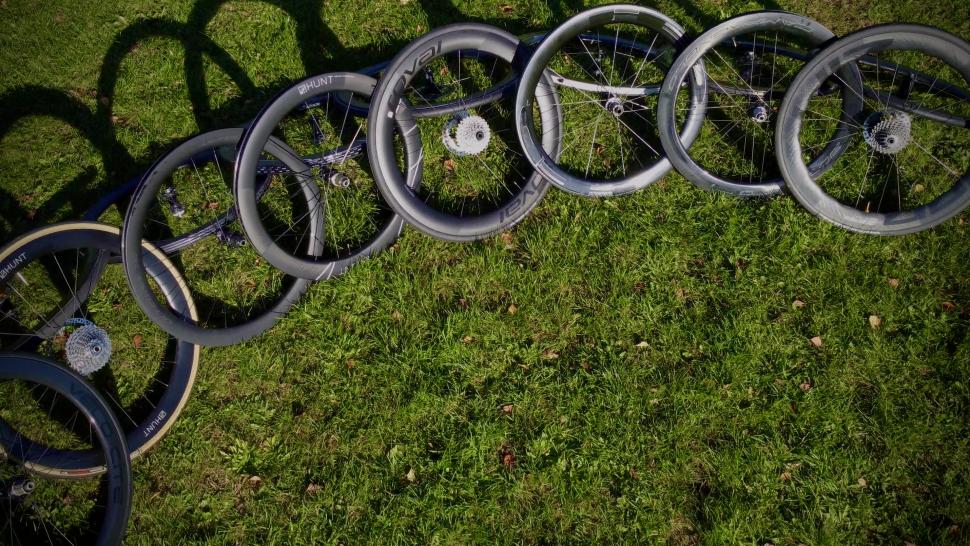




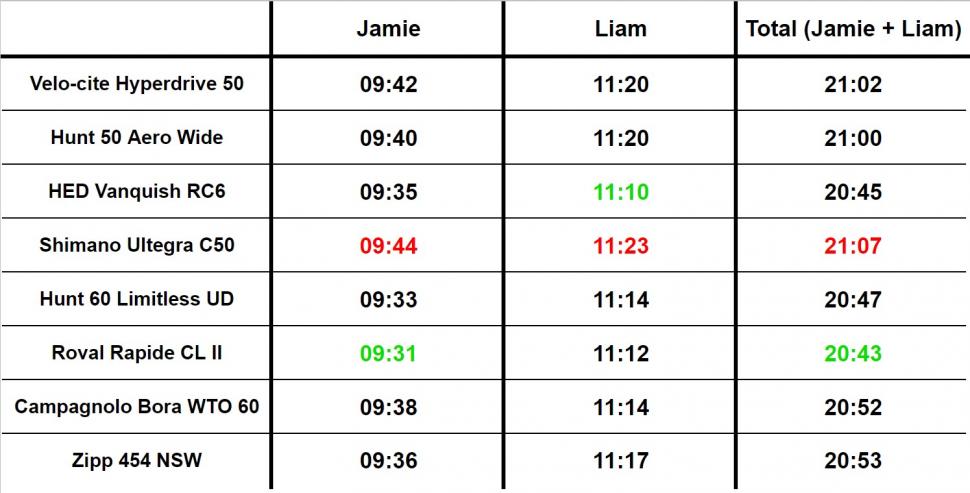
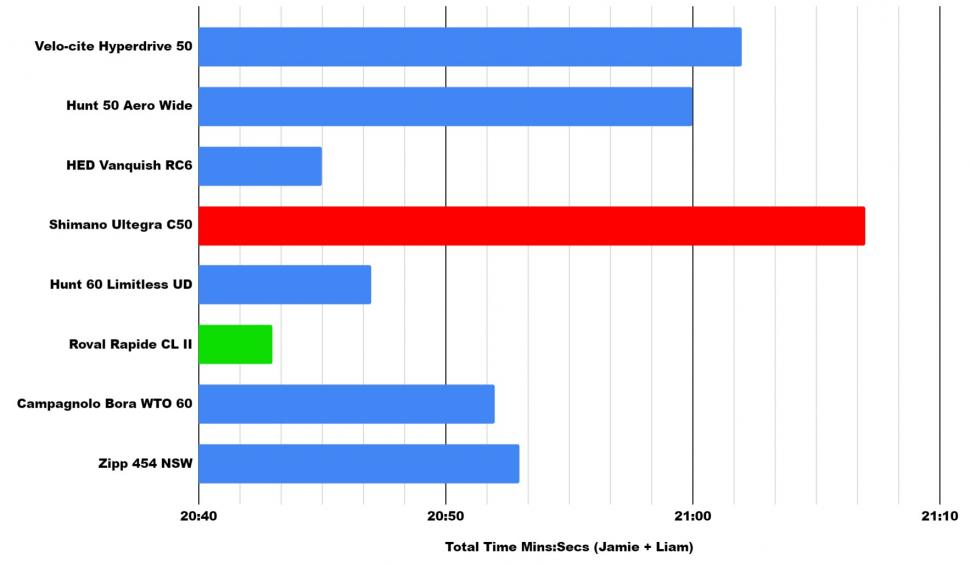


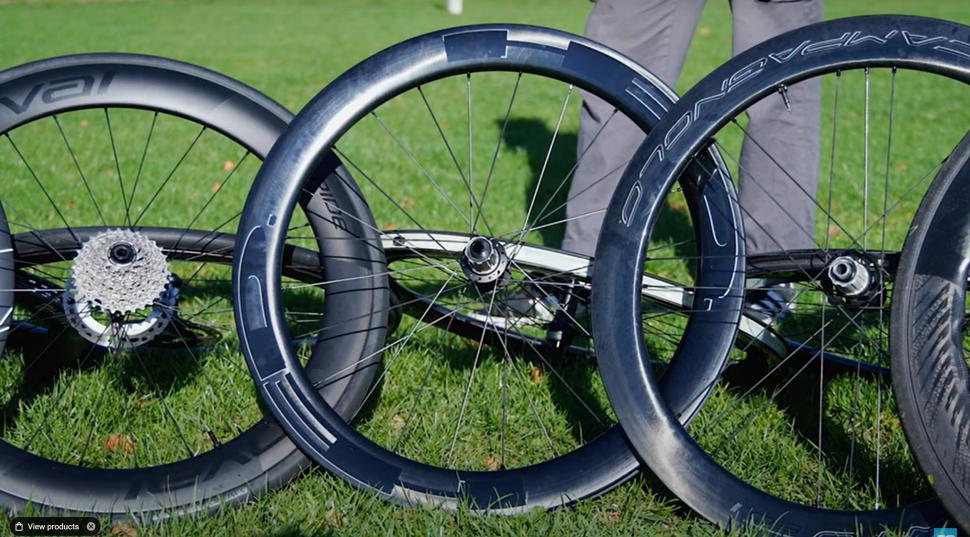
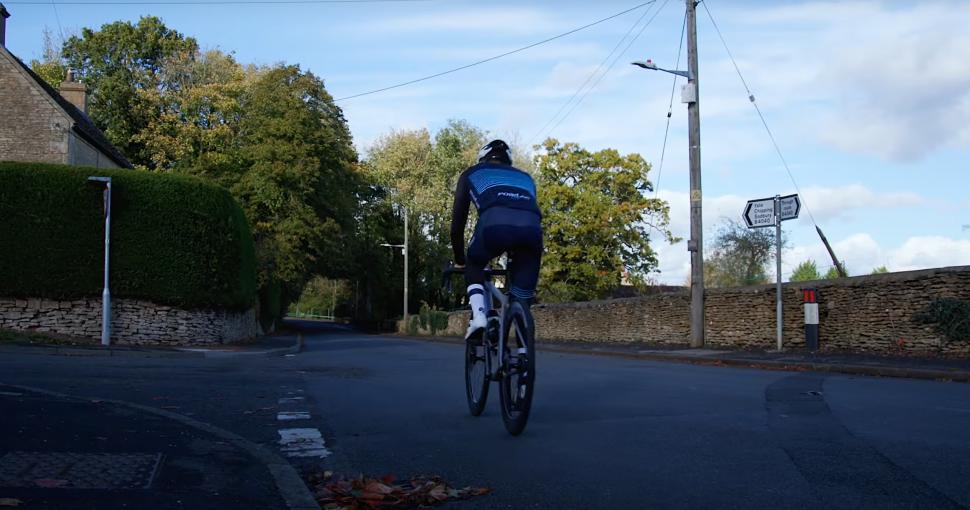

Add new comment
23 comments
Thinking about the results, the biggest differentiator on performance seems to be rim depth. The deeper rims performed better than the shallower rims.
Interestingly the Roval wheels did best of all with the 51 / 60 mm split.
Going back many years, a key aero argument around deep sections was that gains became more significant once the depth / width ratio was over 3/1.
Looking at 28mm tyres being the 'norm' now, that means a minimum rim depth of 56mm to see the big benefits that used to be achieved from a 50mm rim and 25mm tyre.
It certainly supports my desire to go deeper next season.
This article and the comments are focussing too much on performance, weight and price, forgetting the real, most important reason one needs deeper section wheels. One of my bikes has the 1st gen Roval CL50 wheels and it sounds like a TIE fighter over 30km/h.
tbf its explicitly called out on the Campy's
Completely unconnected but also worth noting the Hunts are now available with a quiet free hub at checkout. Also ordererable as spares for 40 squids.
I'd like to know more about how each wheelset rides - or do they all feel pretty similar. I suspect that minute variations in your body positions will make more difference to drag than the differences between wheelsets.
It's not either/or. Just because your body position matters more doesn't mean the effect of the wheels disappears. Ideally you'd optimize both.
Thats totally subjective though. You're into "Vinyl sounds warmer" territory.
Thats always the first thought that goes through my head when you see reviews mentioning stiffness or lack of on a wheel or frame test. I'm unconvinced thats reliably detectable via the medium of 2 feet 2 hands and an arse. (Slap some strain gauges on it or put it in a bending rig)
I too would have liked to see a non-aero wheelset used as a baseline so we can see how little/much speed we gain for our £££. Well done to the testers for the time and effort expended to produce these results.
I calculated some differences based on each of them riding for 1 hour on the Roval wheels. Interesting that the HED was slower than the Roval and Hunt 60 for Jamie but faster than both those wheels (and all the others) for Liam. Perhaps the 30.6mm wide rim was better with the 28mm tyre than 26mm.
Here's the thing you guys just don't get. Expensive bikes and bike gear are the poor man's supercar. I did the math once and my SL6 Specialized S-Works Tarmac Di2 cost more - per pound - than a McLaren. And frankly, having driven a McLaren and several V12 Ferraris, I can attest that I prefer my bike (old as it is now), to a heavy, wide and fat car that I can't drive outside of second gear without seriously breaking the law. With apologies to James May, it is arguably more fun to ride a bike fast than to drive a fast car slow.
Gentlemen, I salute you for your efforts. The experiment may not pass scientific validation but you obviously put a lot of thought and effort in setting things up.
For me the conclusion is that the performance differences are probably not significant on the type of course ridden (which I guess will be reasonably representative). In other words: it doens't seem to make sense to shell out more from a performance point of view.
I always liked the HED and Roval brands. Also owned a Hunt wheelset but simply couldn't stand the freehub racket - I like riding at night- and donated them to a colleague who doesn't mind.
Genuinely good article, although I doubt I'll ever bother with aero wheels!
Interesting article, I would have liked to see the timings from a the same runs with non-aero wheels - kind of like a control set. As you said the difference in timings between them is limited - but what would it be like against a basic training wheel?
Agreed, and also a slightly less deep section version of one of the carbon wheelsets tested too, just for rough comparison purposes.
Agreed. As a heavy-ish rider I'm led to believe that I would benefit more from deeper section wheels, but my heart still says that a lighter weight set of e.g. 30mm Fulcrum Zeros would 'feel' faster or at least more fun. Would have liked to see how they compared against the Boras in particular.
What I'd love to see in these reviews is some way of measuring wheel wind up... how well do they get up to speed.
Not sure of a practical protocol for this, maybe you could time how long it takes to accelarate from 10 -25mph over say three runs per bike. Problem would be controlling power consistently between runs, to factor in fatigue etc.
Maybe lapping between efforts, and creating sosme form of average power / time equation.
In my experience the variability in wheels is more acutely felt when under load, and I suspect some of the performance justifying higher price tags will be how well a wheels transfers power.... maybe.
I remember borrowing a set of Zipps for a prologue TT, and being completely blown away by how dead the wheels rode. I'm sure over the course of a road race, they'd be quicker, but punching out of corners, they were disappointing (to put it mildly).
That's a simple mechanical calculation and the answer is that all other things being equal, the heavier wheel will require more energy to come up to speed. But by an order of magnitude, the overall system weight will outweigh the wheel influence. Once rotational speed has been built up, the heavier wheel will benfit from inertia vs the lighter wheel. But again, the influence of the wheel will be small compared to the total system inertia. Strictly for the wheels and ignoring other aspects, you would clearly benefit from a light wheelset in circumstances where lots of acceleration/deceleration or lots of climbing are involved. It'll be a lot less clear-cut on straight roads with little or no changes in speed.
But I believe all of this becomes not negligible but of minor importance when considering the forces working on the entire system and their impact, notably air resistance. Once you start riding faster than about 16 mph, air resistance becomes THE limiting factor and the largest contributor to that is the guy sitting on the bike. Most amateur riders will expend ridiculous amounts of cash on marginal mechanical gains but a better position or less weight to bring up to speed would be a lot more effective, not to mention cheaper. You can't outsmart the laws of physics.
I getcha, but there is a third element that you've not touched on, which is how efficient the wheels are at transferring power.
At low/moderate powers, this is fairly irrelevant (as tested here), but for 700w+ efforts out of corners or responding to attacks, the load on a wheel is pretty significant.
Going back to my Zipp example. Back in the day, the Zipp rims were not strong enough to support sufficient spoke tension to resist lateral load /spoke wind up and they flexed badly. As this was during the time of rim brakes and narrow tyres this meant rims rubbed brake pads and tyres on frames. Nasty.
It's arguably less of a challenge now with discs, bolt through axles and wider clearances, but still an area that might provide greater competitive performance differentiation than one might expect.
More grease in the freehub will cause the wheels to be slower while pedaling?🤔
Downhill and BMX racers are known to strip the grease from bearings and hubs for race runs and report a noticeable difference in speed, so maybe?
I noticed a new set of Ultegra wheels felt a bit tight when spinning the axle by hand, maybe their hubs just need to bed in a bit.
Indeed, while freewheeling (although even then I suspect that the "noticeable difference" has more to do with sensory cues suggesting speed than with actual speed, but that's another matter). But this test was about pedaling, so the freehub was locked up the whole time.
Yeah, that makes some sense for the main hub bearings (still, 13 seconds worth of difference over 10 minutes at 300 watts? I doubt it), but not for the freehub, which is locked up and functions as a fixed unit while pedaling.
Yeah fair points, I'm confusing grease on the pawls with grease on the bearings. You wouldn't think I was an engineer by trade would you! 🙄
This article needs a TRIGGER warning about the upside down bikes.
I have a nasty facial twitch because of this now. They'll be lying them down on their right-hand sides next.....
Argh, its set off my PTSD... all I can think about is bleeding Ekar brakes!